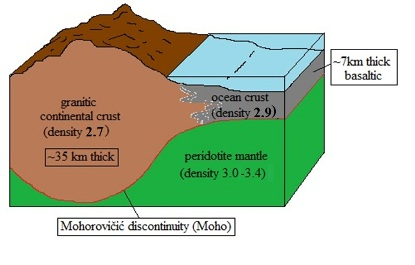Chemical composition - 'crust' and 'mantle'
The surface of the Earth is the top of the 'crust' - whether one is under the sea or on land! By and large, the portions of the crust that poke above the sea to form land consist of 'continental crust'. If you were to drill into this, you would find rock with an overall composition similar to granite - a rock rich in the minerals feldspar and quartz (aluminium and silicon).
Continental crust is thick - but after about 35 km of drilling, you would finally come to a different layer with a different chemical composition at a boundary called the Mohorovicic Discontinuity or Moho (named for the Croatian seismologist who discovered it). Below this boundary the rock changes to one rich in iron and magnesium, and the main rock type is called peridotite. This rock is characteristic of the upper parts of the Earth's mantle.

Chemical layering of
the crust and upper mantle
Image courtesy of Pete Loader.
If you were to take a drillship and drill through the crust of the ocean floor, however, you would encounter a very different type of rock. Oceanic crust is made of a rock called basalt, which is darker and more dense than continental crust. You would only have to drill for about 7 km before crossing the Moho and entering the upper mantle.
Below the Moho, the mantle extends to the surface of the Earth's outer core - about 2890 km down.